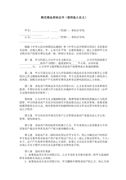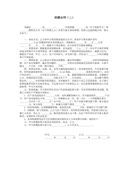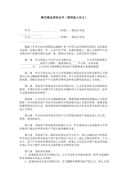四年级英语下册Unit 2英文教案表格式(通用3篇)
四年级英语下册Unit 2英文教案表格式 篇1
teaching plan
date:5/23 teacher: mia
text bookfun with english 4bunit
8
title
open day
period 1
aims 1. students can use the sentence pattern “there be” to describe the decorations. pay attention to the singular form and plural form. ss should know when to use there is and when to use there are.2. to present students vocabularies, familiarize and enable to recognize, and try to spell.3. to cultivate their interest of learning english and the consciousness of communicating in english.
main points and difficult points1. vocabulary: vocabulary: a chair, a blackboard, a computer, a picture, a bookcase, a tape recorder, a music room, an office, a playgroundthe students can say and spell the old words fluently. and say the new words correctly.2. sentence: what’s in the classroom? there is / are … what’s in/ on/ near …? there is / are …in/ on/ near …the students can use the dialogues in life.
aids pictures, tape recorder, multimedia,step 1 everyday reportstudents say a sentence about today in english.step 2 presentation and b: look, read and learn1. t: look at my picture. so what’s this?s: a picture.t: what can you see in the picture?s: i can see a library.t: what can you see in the library?s: i can see some chairs, some computers and some bookcasest: can you see any chairs / computers / bookcases in our classroom?s: yes, i can. / no, i can’t.2. t: what can you see in this picture? (a music room)s: i can see a piano, a violin and an accordion. t: is this a library? is this a …?s: no, it isn’t.t: what’s this in english?s: it’s a music room.t: i can see … in the music room.3. sing a song: in the music room. in the music room, there’s a little piano, whenever we sing, it will sing along, do, te, la, so, me, so, do, te, le, so, whenever we sing, it will sing along.t: what’s in the music room?ss: a little piano. t: yes, there’s a little piano. write on the blackboard, and get students to read it. ask more question, what else is in the music room?ss: there’s… /there are….4. t: look at this picture. is this a music room?s: no, it isn’t.t: it’s an office. ss: office.t: what’s in the office?s: there is a bookcase in the office.t: what’s in the bookcase?s: there are some books in the bookcase. t: there are … 5. miss yao is giving you an english lesson, where’s miss yao? s1: she’s in the classroom. when you have a pe lesson, where are you? s2: in the playground. (teach the new words: playground)step 3 practice
1. t: what’s in the …?s: there is / are … in …2. let’s have a break. shall we go to the park?
ss draw something on the blackboard. then use the sentences there is /are … to describe the park. through this dialogue, ss can know how to use there be pattern drills. let them ask and answer in pairs. ask some pairs to present.
step 4 c work in pairs
1. do part c in pairs.
2. check some pairs.step 5 homework
1. read and write the new words and the sentence.
2. do a survey what would you like? ask your friends or parents.step6 design of writingunit8 open daywhat’s in the classroom? there is / are … what’s in/ on/ near …? there is / are …in/ on/ near …resourcesreference book
postscript in this class, students learn the words about places at school, and things in the classroom. they can see these real things anytime, so it’s easy for them to master. there be is a new sentence for students. i need to spend more time to explain when use is, when use are. then give them some exercise to review and check.date:5/25
text bookfun with english 4bunit
8
title
open day
period 2
aims 1. to provide students with basic language to ask and answer.2. review the there be sentences.3. to cultivate their interest of learning english and the consciousness of communicating in english.
main points and difficult points1. pattern drills:use what’s in the classroom? there is / are … what’s in/ on/ near …? there is / are …in/ on/ near …correctlythe students can use the dialogues in life.3. sentence: sometimes we watch tv in class. there are lots of … let’s go and see.part d look, read and completethe students can communicate with each other.
aids pictures, tape recorder, masksstep 1 reviewshow some pictures and practice: exp: what’s this?ss: it’s an officet: what’s in the office?ss: there’s… /there are…in the bedroom. (according to the picture.) write the sentence pattern on the blackboard. and students read again.step 2 presentation and practice1. t: look at my bedroom. what’s in the bedroom?
s1: there is / are …in the bedroom.
t: what’s near the window?s2: there is / are … near the window.t: look at our classroom. what’s in our classroom?s2: there is / are … in / on / near …students try to say a complete sentence: there’s a computer in my bedroom, sometimes, i play computer games, sometimes i surf the internet…pay attention to the new words: sometimes. 2. let ss practise the sentence there is / are … in / on / near …step 3 d look, read and complete1. do part d in groups. 2. check some pairs.3. do more practice with students. try to make new dialogues in pairs.step 4 read and say
1. t: (look at the picture about part a.) t: what can you see in the picture?ss: i can see a classroom.t: what’s in the classroom?ss: there is / are … (a blackboard/ a tv/ some desks/ some chairs)t: today is the open day. do you want to know more about their school?
2. answer the questions:
(1) what do they sometimes do in class?
(2) what’s in ben’s friend’s classroom?(3) what’s in the music room?(4) what’s in the library?3. listen again with books closed. ask ss to remember some important sentences of each picture. retell the dialogue.t: what are they saying? 4. listen and repeat.5. read by themselves. then read in roles.
6. practice in groups then check. give some performances. try to introduce our classroom with the pattern drills there be.
step 5 homework
1. listen to the tape, read fluently and try to recite it.
2. prepare for their performances. try to make a new dialogue.
3. copy the new words and pattern drills.step 6 design of writing unit8 open day sometimes we watch tv in class. there are lots of … let’s go and see.resourcesfun with english vcd
postscript students know the meaning of “there be” very well, and they can use the single form very well, but when they use the plural form, they always use there is s, or there are …(single form of the word) a lot of is the same meaning of lots of. students always forget the “s” behind lot. after exercise, i find that i should tell them “a lot of ” “lot of” “some” can connect uncountable and countable words. however “many” only connect with countable words.date:5/26
text bookfun with english 4bunit
8
title
open day
period 3
aims 1. review the pattern drills: what’s in the classroom? there is / are … what’s in/ on/ near …? there is / are …in/ on/ near … try to make new dialogues with the sentences above correctly and properly2. daily communications and expressions: i’ve got a new t-shirt. it’s smart. can you read them / it? i love china. 3. pay attention to the different pronunciations of “ch”
main points and difficult points1. sentenceswhat’s in the classroom? there is / are … what’s in/ on/ near …? there is / are …in/ on/ near …the students can make the dialogues fluently.2. pay attention to the pronunciation of “ch”
aids pictures, tape recorder,step 1 warming-up1. do a survey. model:
s1: hello. what’s in your bedroom?
s2: there is / are … in / on / near …
s1: is there a / an …?
s2: yes, there is. / no, there isn’t.
s1: are there any …?
s2: yes, there are. / no, there aren’t. 2. make new dialogues about asking ways and give some performances.3. sing the song: in the classroomstep 2 e read and act1. teacher makes a model with some students.
t: i’m so happy today. i’ve got a new pencil box. is it nice?
s: yes, it is.
t: what’s on the pencil box?
s: there is a …
t: are there any words on it?
s: yes, there are.
t: can you read them?
s: yes, i can.t: what’s in the pencil box? guess!s: there is / are …2. students show their nice or new things to their desk mate : look at my… what’s in/on the…? 3. listen and answer(1) has david got a new shirt? (2) is the t-shirt smart?(3) what’s on the t-shirt?(4) can gao shan read the words?4. read the dialogue after the tape. read in pairs.5. take some notes : a map of china and give them the sentence pattern: a map of… and a picture of…so students can make sentences themselves.step 4 f listen and repeat1. listen to the tape and pay attention to the pronunciations of “ch”. give them more examples about “ch”. ch: watch, chips, chocolate, china, kitchen, sandwich, peachgive them the example which ch is not pronounced it: school, here “ch” is pronounced “/g/”2. a competition. who can say the sentence most fluently?step 5 g look and read1. look and read. help ss understand the meaning of this story. have fun when reading.2. act out in groups.step 6 g place and say
1. ask questions:
s1: what’s in / on / near the…?
s2: there is / are … in / on / near the …
2. students place the pictures and ask in pairs.
3. teacher asks the students and checks the answers.4. sing the song: what’s in the classroomfirst students listen and learn, then sing together. step7 homework1. complete the exercise book and review the text.2.use the words about jobs to make a new rhyme.3.read, write and recite the words and some important sentences.step8 design of writingunit8 open daych: watch, chips, chocolate, china, kitchen, sandwich, peachresourcesreference book
postscript students are very happy to show their nice things to their classmates, so they can master the structure very well. this dialogue is easy for them to act. in this class, i ask them to make a similar dialogue and they can finish it very well. after learning this unit, students get to know a new pattern drill called there be. this pattern drill is quite important and useful. they learn the grammar rules of this pattern drill. it’s easy for them to master these rules. as a result, they can use there is or there are correctly. by using these sentences, they can describe the decorations of the rooms and try to write short articles.date:5/30
text bookfun with english 4bunit
8
title
open day
period 4
aims review all the words, and sentences, and grammar.
main points and difficult pointspronunciation
aids pictures, slide, tape recorder, multimedia,单元要点unit 8一、 词组 open day 接待日our classroom 我们的教室big and bright 又大又明亮watch tv 看电视in class 在课堂上in your classroom 在你的教室里some bookcases 一些书橱a music room 一间音乐室near the window 窗户附近some songbooks 一些歌本on the piano 在钢琴上lots of books 许多书some computers 一些电脑in the library 在图书馆go and see 去看看in the classroom 在教室里some desks and chairs 一些桌椅a new t-shirt 一件新的t恤some words 一些单词read them 读它们a big box 一个大盒子on the table 在桌子上two small boxes 两个小盒子open the blue box 打开蓝色的盒子a toy train 一个玩具火车a yellow box 一个黄色的盒子 二、句型 this is our classroom. 这是我们的教室。it’s big and bright. 它又大又明亮。there’s a piano near the window. 窗户附近有一架钢琴。there are some songbooks on the piano. 钢琴上有些歌本。there are lots of books and some computers in the library. 在图书馆里有许多书和电脑。let’s go and see. 让我们去看看。can you read them? 你能读出它们吗?let me see. 让我看看。i love china. 我爱中国。 i’ve got a new t-shirt. it’s smart. 我有一件新的t恤。它很好看。 (i’ve got =i have got)what’s in the classroom? there’s a blackboard. 教室里有什么?有一块黑板。sometimes we watch tv in class. 有时候我们在课堂上看电视。the chinese teacher’s lunch is on the chair. 中文老师的午餐在椅子上。 三、本单元重点句型what’s in the classroom? there’s a … / there are some …look, there’s a … in / on / near … look, there are some … in / on / near …四、语法1. 学会正确运用there’s a …和there are some …两种形式,注意be动词和所跟名词要保持单复数一致。2. 掌握相关的介词短语,能正确运用在there be句型中。五、语音chxkb1.comchair chinese lunch teacher china peach sandwich watch chocolate beach whichresourcesreference book
postscript review all these language points, help them to remember them. then have a check.
四年级英语下册Unit 2英文教案表格式 篇2
teaching plan
date:2/28 teacher: mia
text bookfun with english 4bunit
2
title
at a party
period 1
aims 1. to provide students with basic language to how to identify people by using who’s that…? and how to give proper answers2. to present students vocabularies, four body organ words familiarize and enable to recognize.”3. to cultivate their interest of learning english and the consciousness of communicating in english.
main points and difficult points1. vocabulary: body organ: hair, head, eye, ear, nose, mouth (learn before, ss can speak it, but can not spell it) family member: grandfather, grandmother, father, mother, brother, sister (old words)the students can say and spell the old words fluently. and say the new words correctly.2. sentence: who’s the…with…? who’s the…in…?he’s/she’s my…the students can use the dialogues in life.
aids pictures, tape recorder, multimedia, 1. everyday english:t: good morning / afternoon, boys and girls. ss: good morning / afternoon, miss tu.t: how are you? how are you this morning / afternoon / today? ss: i’m fine. / not bad.t: nice to see you! / glad to see you! ss: nice to see you! / glad to see you!t: who’s he /she?t: who’s that boy/ girl?s1: he’s / she’s…2. today’s report! ss make a sentence include “today”.3. lead-inshow helen’s family tree.t: let’s talk about helen’s family. who’s that boy / girl / man /woman…? who’s the one in the blue shirt? who’s the one in the…? s: he’s / she’s helen’s (father / mother / grandfather/ grandmother / brother / sister).4. presentation and practice:(1) a game:quick response: t speak out the body organ words, ss try to point to the correct places.(lead-in hair, head, eye, ear, nose, mouth)(2) open the books, listen to the tape, read after it, try to remember how to spell.(3) have a checktrain train go go go. one student points a body organ, the other one should speak it out quickly, and spell it. (2) point to a student. say who’s the boy/ girl with…? let ss understand this sentence. help ss respond properly. he’s / she’s … do more practice with ss.with long / short hair with big / small eyeswith big / small earswith a big / small mouthwith a big / small nosewith a big / small head(3) show some photos of the ss. ask questions like followings: t: who’s the boy / girl / man/ woman with…?s: he’s / she’s…(4) let students ask and answer in pairs. then check several pairs.5. ask and answer:show the pictures of part c. ask and answer. a: who’s the…with…? b: he’s / she’s my… picture1: a: who’s the man with big ears? b: he’s my father.picture2: a: who’s the woman with long hair? b: she’s my mother.picture3: a: who’s the boy with a big mouth? b: he’s my brother.picture4: a: who’s the girl with a small nose? b: she’s my sister.6. play a game: do a puzzle t: the girl is with long hair, big eyes, small nose, small ears, and big mouth... through this game, ss can do a puzzle by teacher’s description. so they can understand better and learn the new words better. 7. production: distinguish the two sentences.(1) the one in…is…(2) the one with…is…make a dialogue with two sentences in correct way.eg. a: who’s that man? b: which one? a: the one in blue shirt. b: he’s…, i think. a: no. the one with big eyes. b: he’s… a: you’re right.8. conclusion:evaluate students’ performance and give homework.9. homework:(1) prepare part a(2) read and write the new words and the sentences. (3) talk about their own photos by using who’s the…with…? he’s/ she’s …10. design of writing:unit 2 at a partya: who’s the…with…? hair, head, eye, ear, nose, mouthb: he’s / she’s my…resourcesstationery relating words, connecting with 3bunit3
postscript students need to pay more attention to the spelling of “with”. they need to practice writing. after the winter vocation, their writing is not as good as before. they learn the phonetics: the pronunciation of “c”, which can help them remember new words much easier.date:3/2
text bookfun with english 4bunit
2
title
at a party
period 2
aims 1. to provide students with basic language to ask and introduce people with different vocations.2. to describe the people’s appearance and to ask people’s identity.3.to cultivate their interest of learning english and the consciousness of communicating in english.
main points and difficult points1. vocabulary: new2. sentence: the students can use the dialogues in life.(1) is that girl your sister?(2) which one?(3) the one in...3. part d look and saythe students can communicate with each other.
aids pictures, tape recorder, masks 1. warming up:(1) sing a song: hellohello, hello, hello how are you?i’m fine, i’m fine, i hope that you are too.hello, hello, hello how are you?i’m fine, i’m fine, i hope that you are too.(2) everyday english:t: t: good morning! who’s on duty today?is every one here today?who’s absent?t: who’s he /she?t: who’s that boy/ girl?s1: he’s / she’s…2. today’s report! ss make a sentence include “today”.3. review:(1) ask one student to show them family pictures. review the new words, including the spellings.(2) make dialogues by using: who’s the man with glasses? who’s the boy with yellow hair? who’s the girl with pigtail?4.lead-in and presentation:1) t: please show me your family photo. t: is that your father? (t leads them to say: which one?) t shows the pattern: which one. t explains the meaning.ss read after teacher several times. t: the one in big eyesss: yes, he is.2) t: can you show me your photo?s: yes.t: is that your mother?s1: which one?t: the one in blue.s1: no, she isn’t.3) please show your family photo and ask the member with your partner. (invite two groups)4) now please turn to page 18, and finish the dialogue with your partner.t invites some groups to make performance.5.presentation1. ss watch vcd2. ss read the story by themselves.3. t give them useful phrases.6. games(1) t: look, here’re many photos. do you know what photos are they? please, guess what photo is this?s: my grandfather.
t: yes, you’re right. can you spell it?
s: yes, g-r-a-n-d-f-a-t-h-e-r
t: who’s the man with big nose?
s: he’s my father.t: can you spell father?s: yes, f-a-t-h-e-r(2) play a game:hand out some pictures to ss. then ask and answer in pairs as followings:
s1: is that woman your mother?
s2: which one?s1: the one…7. read and say(1) t:(show the picture of mrs black) boys and girls, do you know what’s her job? ss:(listen to the tape recorder.) she’s a nurse.(2) open their books. listen and repeat.(3) read by themselves. then read in roles.(4) practice in groups then check. give some performances.8. conclusion: evaluate students’ performance and give homework.9. homework:(1) listen to the tape, read fluently and try to recite it.(2) prepare for their performances. try to make a new dialogue.(3) copy the new words and pattern drills.(4) the ss who has already well grasped (3) can challenge the following work:
write a short passage about a person. they can mail it to me. (分层作业)10. design of writing:
unit 2 at a partyis that woman your mother?
which one?the one…resourcesfun with english vcd
postscript learning the pronunciation is a little difficult. the students listen carefully. review old words, and then teach the new words. they need practice more. they can speak but can’t write it down. date:3/3
text bookfun with english 4bunit
2
title
at a party
period 3
aims 1. 1. help students try to make new dialogues according part a.2. to use pattern drills to make short dialogues 3. phonetics: the pronunciation of “ck”4. to cultivate their interest of learning english and the consciousness of communicating in english.
main points and difficult pointsphrases: let’s go. part e read and actpart f listen and repeatthe students can make the dialogues fluently.
aids pictures, tape recorder, masks 1. warming up: everyday english:t: good morning! who’s on duty today?is every one here today?who’s absent?who’s the boy/girl in red?2.review:(1) review the new words and the spellings(2) play a game:use masks and guess who’s that…? then act and guess what he/ she does. do this game like followings:s1: is that woman your desk mate?
s2: which one?s1: the one…s2: yes, he is/ no, he isn’t.3. presentation part e read and act:(1) show the picture of part e read and act, do ask and answer.1) what’s the time? (it’s six o’clock)2). where’s your brother? (he’s in the car)(2) look at the picture and listen to the tape recorder.(3) listen again and answer the questions: what are they late for? (they’re late for the party)(4) learn the new points: late for, let’s hurry and in the car (review the phrase we have learnt last unit (in the tree). summarize some phrases about come, such as let’s go, etc.) (5) listen to the tape and understand the meaning(6) let the students prepare the dialogue in groups.(7) give us some performances. find out the best one and give them some prize.4. f listen and repeat(1) listen to the tape and pay attention to the pronunciation of “ck”. give them more examples about “ck” as followings: 1) ck: back(2) a competition. who can say the sentence most fluently?(3) little fox:ck: /k/ jack found a clock. tick, tick, tick goes the clock. jack put a clock in his sock.tick, tick, tick goes the clock.jack found a chick.pick, pick, pick goes the chick.jack put the chick in his backpack.pick, pick, pick goes the chick.jack found a duck.quack, quack, quack goes the duck.jack put his duck in his bucket.quack, quack, quack goes the duck.jack found a lock.click, click, click goes the lock.jack put the lock on his truck.click, click, click goes the lock.5. conclusion: evaluate students’ performance and give homework.6. homework:a) recite part eb) finish textbook aunit 2 at a partyresourceslittle fox
postscript after learning this article, the student can say: who’s the boy? he’s a…. and ask something they want. some students are confused by the plural forms of nouns. date:3/7
text bookfun with english 4bunit
2
title
at a party
period 4
aims 1. review the pattern drills: who's the …with.. he's/she's (my)…? is that…your…? which one? the one in the…try to make new dialogues with the sentences above correctly and properly2. to cultivate their interest of learning english and the consciousness of communicating in english.
main points and difficult points1. look and readss can make new dialogues by themselves.2. play a gamethe students are interested in this game.3. say a rhyme
aids pictures, slide, tape recorder, multimedia,1. everyday english.t: who’s he /she?t: who’s that boy/ girl?s1: he’s / she’s…2. today’s report! ss make a sentence include “today”.2test book aa) listening partb) writing part3. review(1) give performance according to part e(2) speak out the sentence about “ck”3. part g fun house(1) look and read. this is an interesting story and the children like it. by reading the story, the students can review the important sentences and words. if time is possible, some of them can give their performances. (2)show a family tree. ss know the relationship of relatives very clear. at the same time they can know how to use this kind of dialogues in reality. they will be self-confident in the future studying. e.g. a: he’s my father’s father. who’s he? ss: ss speak out his name.(2) play a game guessing game he’s my father’s father. who’s he?ss: ss speak out his name.(1) say a rhyme.change the words. add man, woman, girlif time is enough, they can have a competition.4.evaluate students’ performance.5.homework:(1) finish test paper b(2) prepare unit 3resourcesreference book
postscript learning the pronunciation is a little difficult. the students listen carefully. review old words, and then teach the new words.
四年级英语下册Unit 2英文教案表格式 篇3
teaching plandate:3/9 teacher:mia
text bookfun with english 4bunit
3
title
what’s your job?
period 1
aims 1. to provide students with basic language to introduce people with different jobs.2. to present students vocabularies, eight vocation words familiarize and enable to recognize.”3. to cultivate their interest of learning english and the consciousness of communicating in english.
main points and difficult points1. vocabulary: job: policewoman, waiter, waitress, worker, cook, farmer (new words)job: policeman, driver(old words)the students can say and spell the old words fluently. and say the new words correctly.2. sentence: what’s your / his / her job? i’m / he’s / she’s a … what are their jobs? they’re …the students can use the dialogues in life.
aids pictures, tape recorder, multimedia, 1. everyday english:good morning / afternoon, boys and girls. ss: good morning / afternoon, miss tu.t: how are you? / how are you this morning / afternoon / today? ss: i’m fine. / not bad.t: nice to see you! / glad to see you! ss: nice to see you! / glad to see you!t: what day is it today?s1:it’s …t: what’s the weather like today?s2:it’s…today's report. ss ues "today" make a sentense.2. lead-int: i’m miss tu, what’s your name? s1: i’m…t: what’s his/her name?s2: he’s/she’s…3. presentation:t show a picture of liu tao's family tree.this is liu tao’s family tree.t: who’s he?s1: he’s liu tao's father.t: what’s his job?ss: he’s a …. (ss try to guess his job)t: he’s a policeman.read the word several times. (little train, loud voice and low voice)train train go go go.t: what’s her job?ss: she’s a …(ss try to guess his job)t: she’s a policewoman.read the word several times. (little train, loud voice and low voice)train train go go go.pay attention to the pronunciation of the two words.man /ӕ/ → policeman /ә/ → woman /ә/ → walkman /ә/ → postman /ә/→ fireman /ә/try to find some commence and differences between the two words. t give some hits, ss try to conclue.policeman 是警察的总称 policewoman 女警察same way to teach the other two words “waitress” and “waiter”waiter(男服务员)---waitress(女服务员) 4.practice: (1) practice the four words by missing game. (2) passing game: when music stops, ss should say a sentence like this:policeman, policeman, i’m a policeman.(3)role play.t: what's his/her job?s: he's/ she's a ...s1-s2 make a dailog like this.(write the key sentences on the blackboard.)5.presentation: show some things to ss, they try to guess the people’s jobs.6. practice:(1) act and sayppt present a word, ss try to speak the word and sentence and do an act.…,…, i’m a …(2) pair workmodel: t makes guestures of a kind of job.t: what’s his/her job?ss: he’s/she’s a… ppt shows some people, but not very clear, try to guess their jobs. ss do it in pairs, and then choose some pairs to act it. 7.performance: ask one student come to the front, and give him/her a word. the student should do an act. then the other students do ask and answer.s1: what’s his/her job?s2: he’s/she’s a …ss: are you a…?s: yes, i am. / no, i’m not.ss: what’s your job?s3: i’m a …8.consolidation: do exercise9. conclusion:evaluate students’ performance and give homework.8. homework:(1) prepare part a(2) read and write the new words and the sentences. (3) practice part c ask and answer.9. design of writing:unit 3 what’s your job?a: what’s your/his/her job?b: i’m/he’s/she’s a…
resourcesreference book
postscript the aim of this lesson is let students to learn all the job words.all the new words are not eszy to read, the students are confuese about the prounceation of them. so i let them play games to remember them.date:3/10
text bookfun with english 4bunit
3
title
what’s your job?
period 2
aims 1. to provide students with basic language to ask and introduce people with different jobs.2.review the grammar general question. according to the questions, learn to try give yes or no answer.3.to cultivate their interest of learning english and the consciousness of communicating in english.
main points and difficult points1. vocabulary: new2. sentence: the students can use the dialogues in life.(1) welcome to our school.(2) i’m new here.(3) pattern drills: are you a…? yes, i am. / no, i’m not.3. part d look and saythe students can communicate with each other.
aids pictures, tape recorder, masks 1. warming up:(1) say the rhyme: fly fly fly a butterfly. fly fly a butterfly.in the meadow is flying high.in the garden is flying low.(2) everyday english:t: good morning! who’s on duty today?is every one here today?who’s absent?what day is it today?what’s the date today? what’s the weather like today?(3) today’s report.ss make a sentence include “ today”. 2. review and presentation.(1) show pictures with many people and ask: what are their job?ss may say he’s or she’s or it’s….t helps them and correct: they’re postmen. (t writes down)t: are they waiters?ss: yes, they are.t: are they workers?ss: no, they aren’t. t: what are their jobs?ss: they’re drivers?t: very good. now boys ask, girls answer.bs: what are their jobs?gs: they’re cooks.t: look at the picture. and now exchange, girls ask boys answer.t: i’ll invite a student to come and ask: are they …?ss: yes, they are.using this method to review the words and to practice the sentence which in plural forms.4. presentationss watch flash of the passage. then answer my questions.t: what’s his name?ss: jack.t: how old is he?ss: one.t: what his job?ss: waitert: what are their jobs?ss: they’re drivers.t: please open your books and turn to page 22, please read together. ss underline some important knowledge points and emphasis them.ss read after the tape, and practice with their partners.4. gameslet’s play a game. guess who is s1’s friend.t: listen carefully. is your friend a boy? ss: yes, no, my friend is a girl.t: how old is she/he?ss: she’s 11.t: are her eyes big?ss: no, her eyes are small.t: is her hair long?ss: yes, her hair is short.t: your friend is s2, i think.ss: yes, you’re right.t: after class, you can practice with partner.5. conclusion: evaluate students’ performance and give homework.6. homework:(1) listen to the tape, read fluently and try to recite it.(2) prepare for their performances. try to make a new dialogue.7. design of writing:
unit 3 what’s your job?what’s your job?i’m a …
resourcesfun with english vcd
postscript help the students review the preposition “his” and “her”. the students of grade three cannot understand the rule completely. date:3/14
text bookfun with english 4bunit
3
title
what’s your job?
period 3
aims 1. 1. help students try to make new dialogues according part a.2. to use pattern drills to make short dialogues 3. phonetics: the pronunciation of “dr” and “tr”.4. to cultivate their interest of learning english and the consciousness of communicating in english.
main points and difficult points1. sentences: what’s your / his / her job? i’m / he’s / she’s a … what are their jobs? they’re …how old are you?i’m … how old is he / she? he’s / she’s …the students can make the dialogues fluently.2.daily communications and expressions: it’s cold today, isn’t it? guess! about sixty? 3. pay attention to the pronunciation of “dr” and “tr”
aids pictures, tape recorder, masks1. warming up:(1) say the rhyme: fly fly fly a butterfly. fly fly a butterfly.in the meadow is flying high.in the garden is flying low. (2) guessing game: who’s my friend?is your friend a man or woman? xkb1.comhow old is she / he? are … eyes big / small? is her / his hair long / short?(3)act and guesswhat’s your / his / her job? i’m / he’s / she’s a … what are their jobs? they’re …(4)today’s report. ss make a sentence include “today”.2. presentation and do a survey(1) what do you want to be? t shows some pictures of different jobs.t: what do you want to be?a teacher? a…?if possible, give more words about jobs, like: a writer, a soldier, a clerk, a taxi –driver, a manger, a dentist, a shop assistant, engineer, professor, lawyer help ss give simple words to answer. then teach the complete sentence: i want to be a / an …(2) do a surveys1: what do you want to be…? s2: i want to be a / an … practice with their classmates. summarize the result as followings: how many boys and girls want to be…?3. e read and act(1) (watch vcd of part e.) who can you see in the picture? how many old women can you see?it’s cold today, isn’t it?who’s that old man in the red sweater?how old is she?explain some points: it’s cold today, isn’t it? about sixty? if possible, give some more words about weather like: hot, sunny, rainy, cloudy, windy, dry, wet(1) read after the tape. (2) act out in pairs. give some performances.4. f listen and repeat(1) listen to the tape and pay attention to the pronunciation of “dr” and “tr”. give them more examples about “tr” and “dr” as followings: i. dr: draw, drinkii. tr: tree, try(2) a competition. who can say the sentence most fluently?5. conclusion: evaluate students’ performance and give homework.6. homework:b) recite part ec) finish textbook aunit 3 what’s your job?what’s your / his / her job? i’m / he’s / she’s a … what are their jobs? they’re …how old are you?i’m … how old is he / she? he’s / she’s …
resourcesreference book
postscript after this class , ss recite the dialogue quickly. but ss can’t create the dialogue freely, they always practice as the model t did.date:3/16
text bookfun with english 4bunit
3
title
what’s your job?
period 4
aims 1. review the pattern drills: what’s your / his / her job? i’m / he’s / she’s a … what are their jobs? they’re …how old are you? i’m … how old is he / she? he’s / she’s … try to make new dialogues with the sentences above correctly and properly2. learn to use these sentences: what do you want to be? i want to be a / an …3. to cultivate their interest of learning english and the consciousness of communicating in english.
main points and difficult points1. look and readss can make new dialogues by themselves.2. do a surveythe students are interested in this activity.3. sing a song
aids pictures, slide, tape recorder, multimedia, 1. test book aa) listening partb) writing part2. review(1) give performance according to part e(2) speak out the sentence about “dr” and “tr”3. part g fun house(1) a) look and read. this is an interesting story and the children like it. by reading the story, the students can review the important sentences and words. if time is possible, some of them can give their performances.b) act in groups(2) do survey: t: what do you want to be? ss: i want to be a / an …
jobs
boys
girls
teacher
doctor
worker
nurse
policeman
policewoman
waiter
waitress
farmer
driver
cook
conclude that : how many boys and girls want to be a/an…?(3)sing a songlisten and learn the song. ask ss to change the lyrics to make a new song by using the words about jobs.they sing happilya farmer, a worker, a driver and a waiter. they sing, they sing, happily, happily together.4.evaluate students’ performance.5.homework:(1) finish test paper b(2)prepare unit 4
resourcesreference book
postscript after learning this lesson, the students know how to ask the others when they can’t find their things. and they master some things around them.




















 扫一扫支付
扫一扫支付